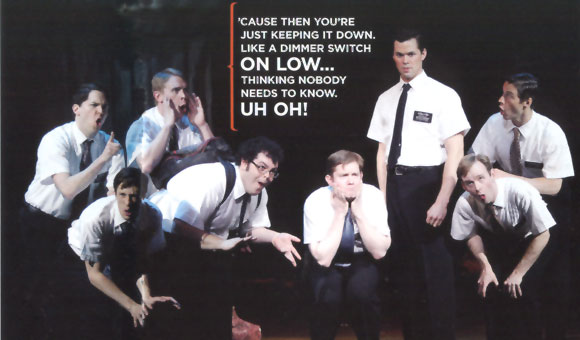 It's a subject that causes editors to sweat, knowing that their newsroom switchboards will almost certainly to explode if they dare to cover it. We are talking, of course, about (cue: drumroll) Mormon underwear.
For many people this subject symbolizes all of the doctrinal topics linked to Mormonism (think Temple vows and the specifics of Temple rituals) that members of the Church of Jesus Christ of Latter-day Saints are not supposed to discuss with those outside their church.
It's a subject that causes editors to sweat, knowing that their newsroom switchboards will almost certainly to explode if they dare to cover it. We are talking, of course, about (cue: drumroll) Mormon underwear.
For many people this subject symbolizes all of the doctrinal topics linked to Mormonism (think Temple vows and the specifics of Temple rituals) that members of the Church of Jesus Christ of Latter-day Saints are not supposed to discuss with those outside their church.
Yet critics of the church -- especially ex-Mormons -- want to talk about these things. They make all kinds of statements on the record about what these secret symbols and rites are supposed to mean.
At that point, reporters and editors are caught in dangerous territory, in terms of basic journalistic ethics.
How do editors (a) verify the accuracy of alleged details (Do ritual Temple dramas and/or media materials teach that traditional Christian churches are in league with Satan?) when (b) responsible, even candid Mormon leaders have taken vows that do not allow them to answer?
How does one write an accurate, fair-minded, balanced journalistic report about, well, Mormon underwear?
BuzzFeed recently tiptoed into this landmine with a respectful, constructive piece on the subject that caught the eye of some GetReligion readers.
The problem, of course, is one that continues to plague your GetReligionistas. This is not a news piece. Once again, how do journalists critique the accuracy and fairness of pieces that are completely one-sided, that represent serious attempts to deal with serious subjects -- but they do so in the form of editorial essays, not news reports?
On one level, the current boom in Mormon underwear interest is linked -- logically enough -- to Mitt Romney's latest White House bid. Thus, readers are told:
It's true that Mormons are taught not to flaunt "garments" (as they're called) for public view, which can feed the impression that Romney's hiding some dark, cultish secret beneath his well-starched shirts and neatly-creased slacks. But the principle behind Mormon garments would be familiar to any Baptist who's worn a "What Would Jesus Do" bracelet, or any Jew who's worn a yarmulke or tzitzit (woven threads Orthodox Jews wear on shawls under their shirts). As the website for the Church of Jesus Christ of Latter-day Saints puts it, garments are worn as "an outward expression of an inward commitment."
Because garments are considered so sacred, Mormons tend to recoil when they hear non-Mormons make casual reference to their underwear -- especially in a political context. But if there ever was a time when discussion of the subject could be contained to Mormon circles, now is not it. Anyone who's attended a performance of The Book of Mormon Musical has already seen actors wearing replicas of the underwear on stage. And as the presidential race wears on, there's no doubt it will come again and again.
The key to this piece is that the author -- McKay Coppins -- is a Mormon and, thus, is able to write this kind of statement: "This reporter is something of an expert on the subject."
The information in the article is, one can only assume, accurate and presented in a fair manner. A key section discusses the claims made by critics that Mormons believe that these garments are "magic." Not really. Do Catholics (and the Orthodox) believe that their baptism crosses are magic?
As a journalist, here's the part that interests me:
Garments today come in two pieces -- a white undershirt, and white boxer brief-style shorts -- and they contain small symbols meant to remind Mormons of the covenants they've made in the temple. ... They also come in a variety of materials -- cotton, polyester, silk, etc. -- to accommodate different climates (a fact for which Mormon missionaries in subsaharan Africa are grateful). Generally, wearing them takes some adjustment at first, but most Mormons report quickly growing accustomed to them. (Out of respect to Latter-day Saints, we are not posting photos of the garments here.)
Here is my question, for those who cover the Mormons on a regular basis. When I worked in Denver in the 1980s, the whole subject of these garments was pretty much covered under the vows of secrecy related to temple rituals. Yet, this article openly discusses this issue and even contains the reference that the garments "contain small symbols meant to remind Mormons of the covenants they've made in the temple."
Where is the line, today, that reporters cannot cross? Where is the point at which a Mormon -- such as Coppins -- must fall silent for perfectly valid reasons due to the vows he has taken as part of his faith? So you can mention the symbols. Can the symbols now be discussed? He mentions the temple covenants. Is it still out of bounds to discuss the contents of the rites and covenants themselves? Is the secrecy line moving?
My question is sincere, in response to this interesting and I would assume -- from the point of view of Mormons who are journalists -- constructive piece. Are there journalists out there from Salt Lake City or elsewhere who can help me understand precisely what is happening, these days, with respectful, accurate, journalism on these topics?
